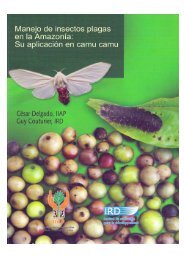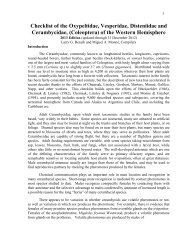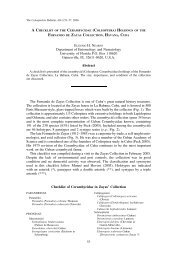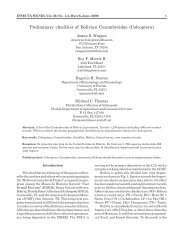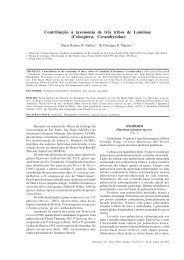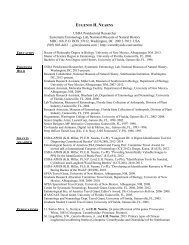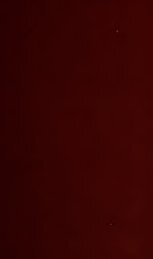Create successful ePaper yourself
Turn your PDF publications into a flip-book with our unique Google optimized e-Paper software.
120 THE TRIBE ONCIDERINI<br />
procoxae subglobose, distinctly Ullcate in male; femora clavate, r"obust; metatibiae<br />
feebly expanded in male. Antennae one and one-half times body length in male,<br />
slightly longer than body in female; scape rather robust, gradually but distinctly<br />
clavate apically, attaining apical third of pronotum; third segment feebly sinunte,<br />
about one-third longer than scare; eleventh slightly longer than tenth in male.<br />
GENOTYPE.-Hesycha bat'ii Jekel.<br />
Alexera harii Jekel<br />
PLATE III, FIGURE 9.<br />
HC8ycha barii Jekel, .Iourn. Ent., 1, 1861, p. 261.<br />
Hywnoma barii Jekel. Lacordaire, Gen. Col., IX, 1872, p. 676.<br />
HypSelomU8 lignicolor Bates, Ann. Nat. Hist., (3), XVI, 1865, p. 169. [New<br />
synonymy.J.<br />
Hypsioma lignicolor Bates. Bates, lac. cit., p. 170.<br />
MALE. Elongate-ovate, rather robust, convex; dark reddish-brown to piceous,<br />
elytra slightly paler; above entirely clothed with fulvous-gray tomentWll, mottled<br />
with dark brown. Head with front almost entirely dark brown, finely vittate later<br />
ally with fulvous-gray. Pronotum each side with a broad, slightly oblique vitta of<br />
pale yellowish-gray, above whi ch is a broad line of dark brown; disk with irregular,<br />
indistinct lines or maculae of puler pubescence. Scutellum broadly dark brown vit<br />
tate medially, sides narrowly yellowish-gray. Elytra entirely fu!vous-gray, each<br />
with two arcuate lines of whitish, one of which runs from basal margin at side be<br />
neath hWllerus obliquely to behind middle halfway to suture, the other nearly con<br />
tinues the first, lunate, curving first towards suture and then continuing the arc<br />
away from it and almost attaining apex, each elytron with several dark brown<br />
streaks, one oblique, posterior to discal portion of first white line, the others longi<br />
.tudinal on apical half, and an indistinct, broad, dark band running obliquely from<br />
humerus to suture at middle. Body beneat.h dark reddish-brown, irregularly<br />
clot.hed with hoary and fulvous-gray pubescence; prothorax lateral to coxae with<br />
an oblique band of dark brown; metepisternum with a broad, oblique, dark brown<br />
.band before middle, posterior to which it is white; abdomen entirely clothed with<br />
sparse, fulvous-gray pubescence, each sternite, except basal one, with-Q.-J"ounded<br />
macula of denser pubescence halfway between middle and side margin. Legs dark<br />
brown to fuscous, irregularly clothed with fulvous-gray pubescence; femora some<br />
what mottled with darker spots ; tarsi thinly gray pubescent, claw segment not<br />
annulate. Antennae dark reddish-brown or fuscous, apax of aach segment only<br />
very slightly paler; entirely clothed with fulvous-gray pubescence, the proximal<br />
segments more distinctly mottled with brown, the bases of the segments beginning<br />
with fourth very narrowly annulate with gray.<br />
Head above minutely punctate, with a median line from occiput to epistorna;<br />
front deeply, but rather broadly, concave between antennal tubercles, sides only<br />
slightly oblique, nearly parallel, densely and finely punctate, although rather roughly<br />
so; genae vertical, oblong, minutely alutaecous, nearly glabrous; eye with lower lobe<br />
vertical, oblong, distinctly narrower below, twice the height of gena; antennal<br />
tubercles weH separated, prominent, apices with a short, robust horn which is bent



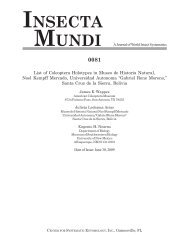
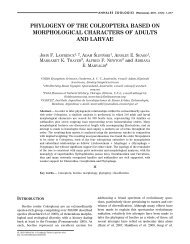


![Coleoptera. Vol. I. [Longicornia. Part I.]](https://img.yumpu.com/41202793/1/180x260/coleoptera-vol-i-longicornia-part-i.jpg?quality=85)
